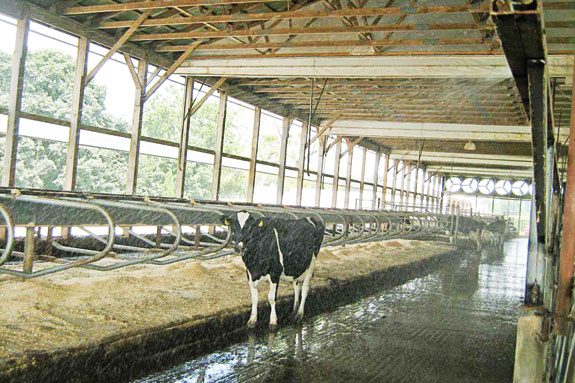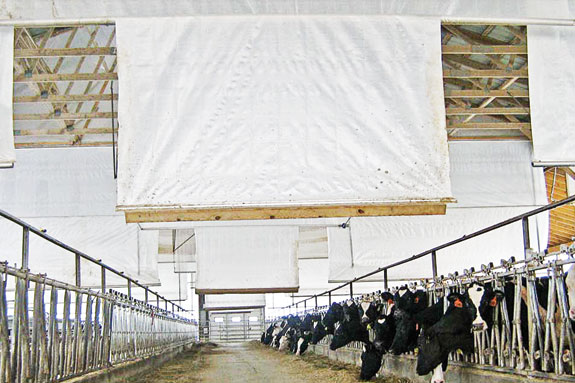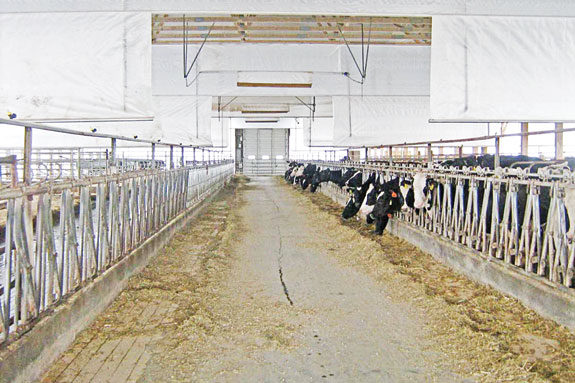Have you been thinking about cow comfort within your freestall barns? One dairyman’s idea could help you cut down fan usage, your electric bill and keep air flowing at a high rate for cow comfort. Kevin Hoover, a Pennsylvania dairyman and owner of AutoVent LLC, has been using an idea he came up with for two years to improve cow comfort.
He hung “motorized baffles” in a specific pattern from the ceiling in his barn to create stronger airflow.
“My barn is 240 feet long by 96 feet wide, and I have the baffles spaced every 44 feet all the way down,” Hoover says. The baffles are curtains that roll down from the ceiling depending on the air temperature conditions within the barn. The baffles roll down and still have about 7 feet of ground clearance beneath.Hoover says the baffles extend from the ceiling automatically when it gets too hot and humid inside the barns.
Hoover’s ventilation controller is set up to automatically roll the baffles up when it is cooler or the wind speed outside of the barn increases. “The controller will raise the curtains on the exterior walls, raise the baffles and turn off the fans when it gets cool and breezy outside to save electrical costs,” he said.

Hoover added that a wind meter on the outside of the barn signals the control system when exterior winds exceed 9 mph. A thermometer also signals the controller when the outside temperature drops below 60ºF.
With the addition of the baffles in Hoover’s barn, he has noticed significantly less heat stress in his cattle. “Even though our herd size increased from 90 to 180 cattle, we still had noticeably less heat stress,” he says.
“Our feed nutritionist, Dan Hillyer, who also observes some other dairies in the area, claimed we had a lower production loss this summer in relation to the other herds as well,” Hoover says.
Hillyer credited the lower production loss to the superior airflow and cooling in their freestall barn. “Their system should equate to more milk, better reproduction and less metabolic stress over a difficult period,” Hillyer says.
Merle Sensenig, a dairyman from Fleetwood, Pennsylvania, says he saw the invention at an open house at Hoover’s dairy farm. “When the baffles in Kevin’s barn began to roll down, you could feel the air speed pick up right away, and that’s what sold me on the idea,” Sensenig says.

Sensenig says he installed baffles into his own barn, which contains 64 dairy cattle and is 150 feet long by 40 feet wide. “I have to roll my baffles up and down manually, unlike Hoover’s automated system,” he said.
He then added that you could definitely feel the difference in air movement when they’re rolled down.
Dan McFarland, senior extension educator in agricultural engineering at Penn State University, says the mechanics of Hoover’s system are quite ingenious. McFarland came to Hoover’s barn with an anemometer to measure the wind speed throughout the barn with and without baffle usage.
Without the baffles the airflow is about 2 to 3 mph. With the baffles extended, the airflow is about 6 to 8 mph.
McFarland had limited observation of Hoover’s system, but also added that if the curtains were raised a little higher, the system might have been even more effective.
McFarland says the physics of Hoover’s system, which creates a smaller airflow inlet into the barn, does two things. First, the air speed is increased through the barn and, second, the static pressure developed by the fans is also increased.
As static pressure increases, air delivery rate of the fan decreases. “Think of the water flow from a hose – if you pinch the end the water will go further and faster, but you can’t fill a bucket as fast,” he says.
One of the benefits Hoover wanted to receive from the baffles was reducing the amount of fans needed to help cool the barn. This he has achieved.
“No matter which way you look at it – HVLS fans, hanging fans from the ceiling or your traditional tunnel ventilation – none of these are cheap, but using the baffles makes the system efficient with the best cow comfort,” he says.
“Even though we increased our herd 100 percent, our electric cost only increased about 50 percent, and I was impressed by that,” Hoover says.
Hoover estimated installation costs to be more than $7,500 for his automated baffle system. “Since this was the first time installing the system and we were experimenting, it was more expensive,” he says. Had it been a more recent construction, it would have been cheaper.
The installation at Merle Sensenig’s barn was a few hundred dollars. “During the winter, I have to move mine up manually, so my system was significantly cheaper, but well worth the investment,” he says. PD
PHOTOS:
“No matter which way you look at it – HVLS fans, hanging fans from the ceiling or your traditional tunnel ventilation – none of these are cheap, but using the baffles makes the system efficient with the best cow comfort.” Courtesy photos from Kevin Hoover.






